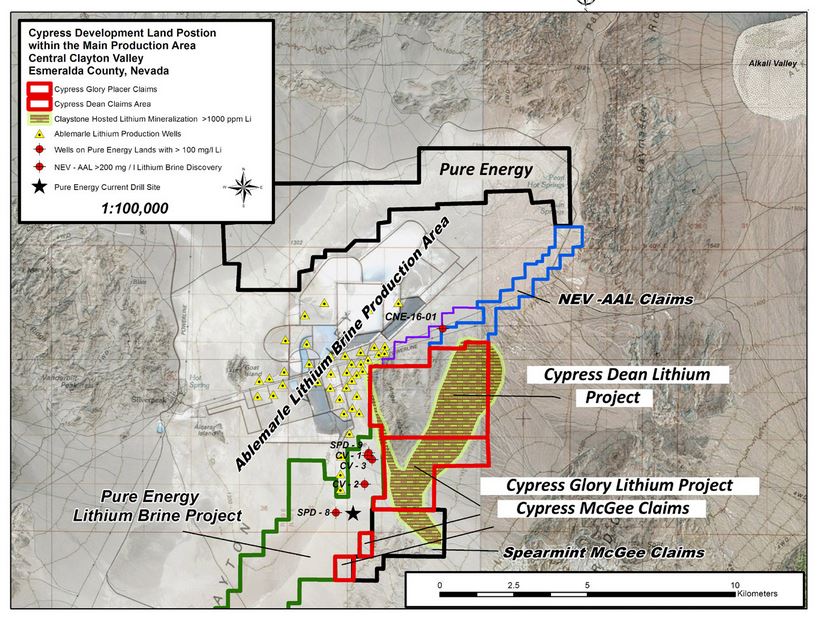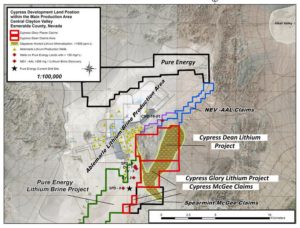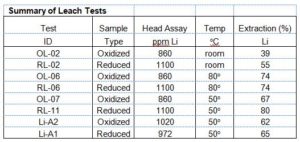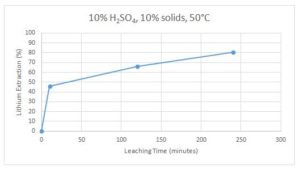Cypress Confirms Leach Results for Clayton Valley Lithium Project in Nevada

Click to Enlarge
Cypress Development Corp. (TSX-V: CYP) (OTCBB: CYDVF) (Frankfurt: C1Z1) (“Cypress” or the “Company”) is pleased to announce additional results that confirm the high solubility of lithium in claystone from its 100%-owned Clayton Valley Project in Nevada.

As previously reported (January 9, 2018 press release), lithium extractions of 74% were obtained for both oxidized and reduced claystone samples from drill core from hole DCH-05, leached in a solution of 5% sulfuric acid heated to 80°C. Subsequent tests reported today show lithium extractions of 67% for the oxidized claystone and 80% for the reduced claystone sample, leached under identical conditions but using a solution of 10% sulfuric acid heated to 50°C. These results are in line with previous results and continue to demonstrate the solubility of lithium found in the subsurface claystone at Clayton Valley using sulfuric acid. An opportunity to improve extractions by adjusting leach conditions is now also apparent.
The Company is also pleased to report core drilling is underway and the first of three additional holes, DCH-15, was completed to a depth of 127 meters, and encountered oxidized and reduced claystone types throughout. As previously announced, this hole was located to test the continuity between two fence lines of holes from the previous drilling. Drilling of the next two holes is expected to be completed by early March and the results included in the upcoming resource estimate.

Cypress’ Lithium Project
Cypress’ primary focus is the Company’s Dean and Glory claim blocks, located in Clayton Valley, Nevada, immediately east of Albemarle’s Silver Peak mine, North America’s only lithium brine operation. Recent exploration by Cypress has discovered an extensive deposit of lithium-bearing claystone, which has been tested by drilling over a seven-kilometer trend across Cypress’ 4200-acre properties.
The lithium mineralization is contained within interbedded lacustrine (lake basin) stratigraphy. These lake bed, volcanic ash rich claystone have been uplifted to their present outcropping position by movement along the Angle Island fault, a typical Walker Lane style shear zone with both lateral and vertical movement. Lithium content of the claystone was found to range up to 3800 ppm on surface. In Cypress’ drilling, the values vary up to 1760 ppm Li over thicknesses of up to 112 meters. In most of Cypress’ holes, a redox boundary has been encountered. This change occurs at depths of between 20 to 30 meters and is seen where claystone above the boundary is oxidized and light grey in color and claystone below is reduced and dark grey and green to black in color. Composite samples for metallurgical tests were prepared recognizing the redox boundary and designated as Oxidized Sample if above the redox boundary or Reduced Sample if below it.
Laboratory Test Work
The Company is continuing laboratory work to determine the solubility of the lithium and other mineral constituents within the claystone. The Company reported at the time that a portion of the lithium is water soluble from simple assay-level tests. Bench-scale testing began in August 2017, when representative samples of oxidized and reduced material from hole DCH-05 were delivered to SGS in Lakefield, Ontario. The primary observation from these tests is the lithium in the subsurface material, at least from DCH-05 core, is almost totally insoluble in water. This contradicts the previously reported tests, which only utilized surface sample material, and suggests the water-soluble lithium occurs as a product of surficial weathering.
Further tests were completed at SGS using various acids and conditions, with the best results occurring in sulfuric acid. In these tests, extractions of 74% were achieved in both the oxidized and reduced samples. These tests used the following conditions, ground to minus-10 mesh, leached for 4 hours at 10% solids in 5% sulfuric acid and heated to 80°C. These extractions were achieved with relatively low acid additions, measured at 140 kg to 170 kg of sulfuric acid per tonne of material, and clearly contrast with the low extractions and high acid consumptions seen in hectorite-bearing claystone deposits.
Present Results
Further tests were conducted at SGS on the core from DCH-05. Following the observation where temperature set to 80°C showed a positive affect and increased the solubility of lithium significantly, subsequent tests were done with the temperature reduced to 50°C and acid concentration increased to 10%. These changes produced a mixed result, reducing the extraction in the oxidized sample to 67% (test OL-07), while increasing the extraction in the reduced sample to 80% (test RL-11). The results are consistent with the previous tests (OL-06 and RL-06), confirming the solubility of the lithium with sulfuric acid for DCH-05 core, and demonstrating the opportunity to improve extractions by adjusting leach conditions. An additional test was done on the reduced material to generate a time-extraction curve, shown below, which shows dissolution of the lithium is relatively fast, reaching 50% in the first hour, and may continue to increase beyond 4 hours.
Further tests are ongoing with the following goals: 1) refining the leach conditions, 2) checking for mineralogical variability from hole to hole, and 3) determining effective means of recovering the lithium from the leach solutions. In December, samples were sent to a second independent laboratory, Continental Metallurgical Services, in Butte, Montana. The two samples were composites of oxidized and reduced intervals from hole DCH-02. A one-hour leach of these samples, using 10% sulfuric acid at 10% solids and 50°C, returned lithium extractions of 62% and 65%, respectively. These results, if plotted on the extraction curve from hole DCH-05, plot somewhat higher, possibly indicating differences do exist in mineralogy from hole to hole, or other differences in laboratory conditions, such as intensity of agitation during leaching. The results are consistent, however, with the observation that the lithium in the subsurface claystone can be leached with high levels of extraction in sulfuric acid.

Samples were ground to minus-10 mesh and leached with a solution of 5% sulfuric acid for 4 hours at 10% solids. OL and RL series samples were core from DCH-05, tested at SGS and leached for 4 hours. Samples Li-A1 and Li-A2 were core from DCH-02, tested at Continental Metallurgical Services, and leached for 1 hour. In all tests, the leach solution was monitored but no additional sulfuric acid was required to maintain an acidic pH. The mixture was then filtered and rinsed with residue and solutions submitted for assay.
Extraction Curve for Reduced Sample, DCH-05

Todd Fayram, MMSA QP #1300, President of Continental Metallurgical Services, LLC, is the qualified person as defined by National Instrument 43-101 and has approved of the technical information in this news release.
To find out more about Cypress Development Corp. (TSX-V: CYP), visit our website at www.cypressdevelopmentcorp.com.
